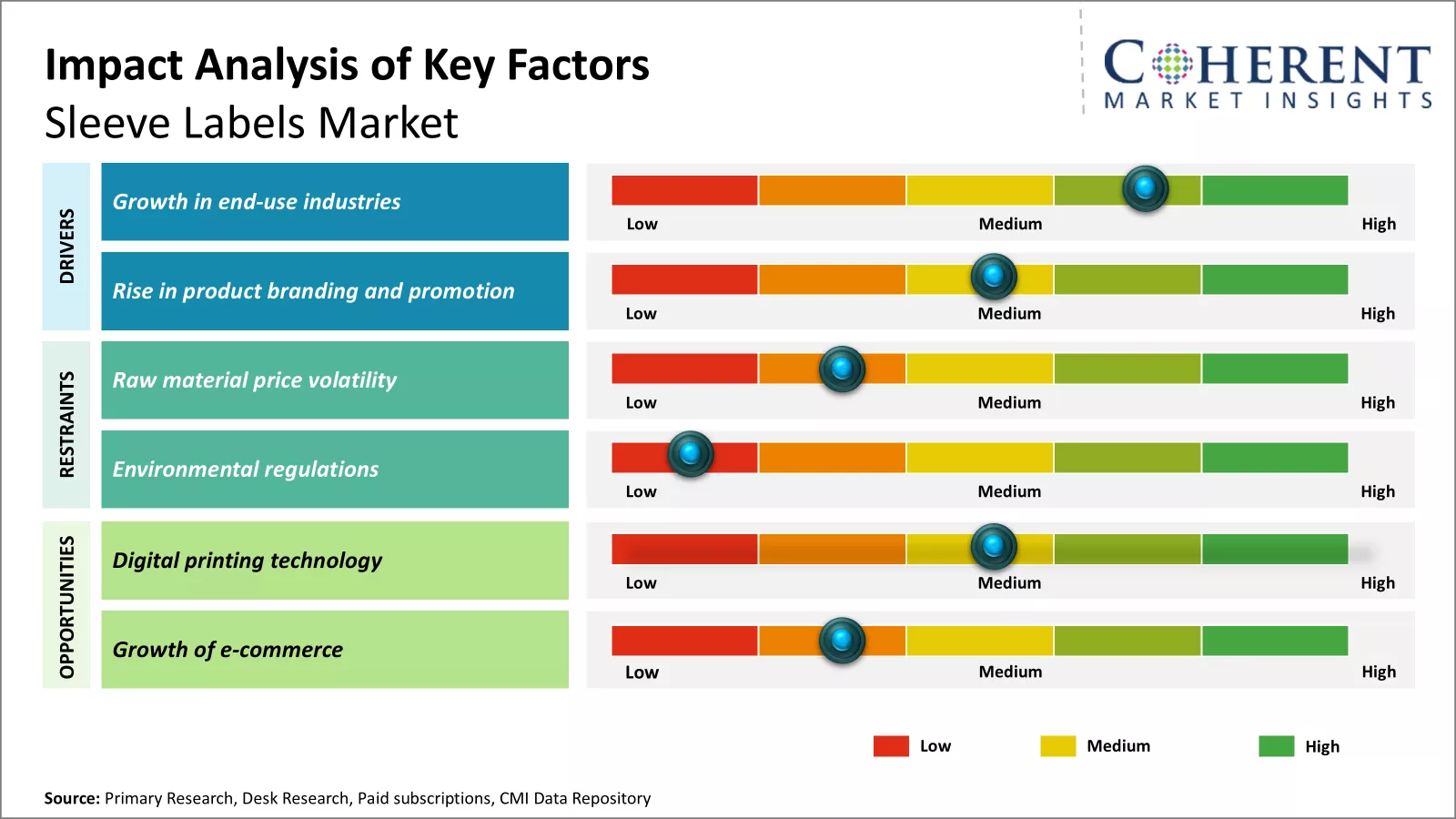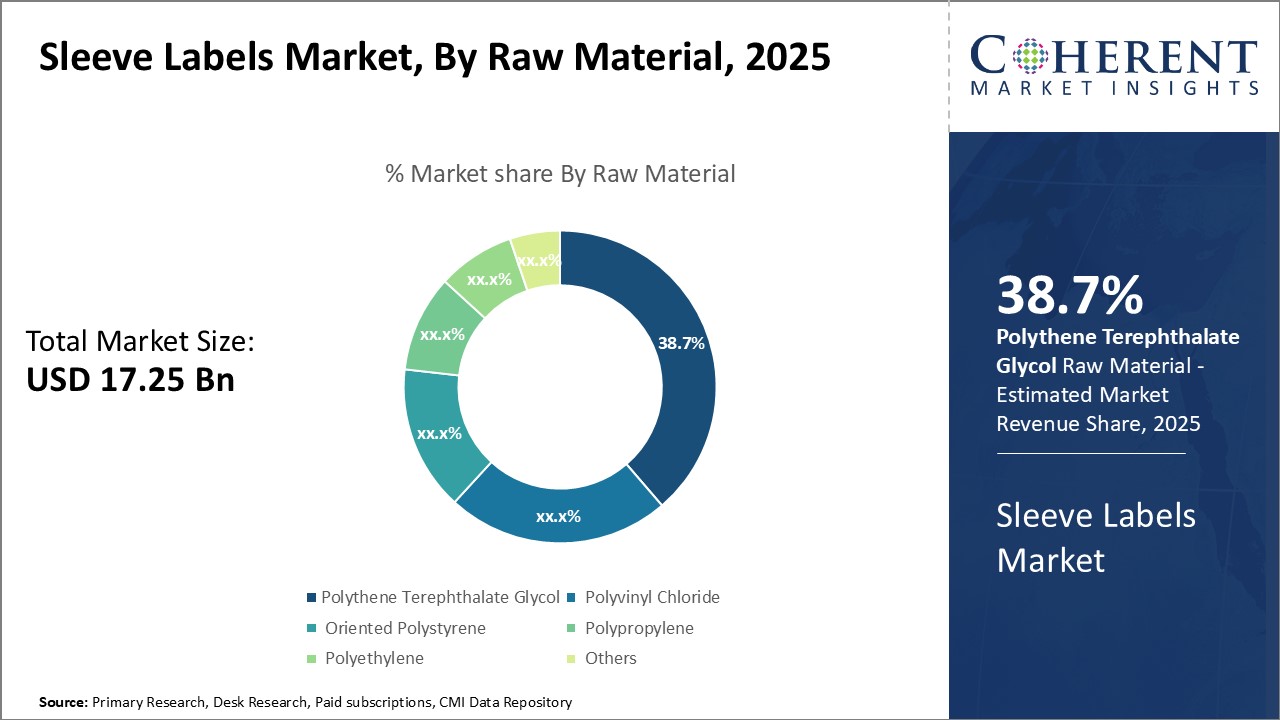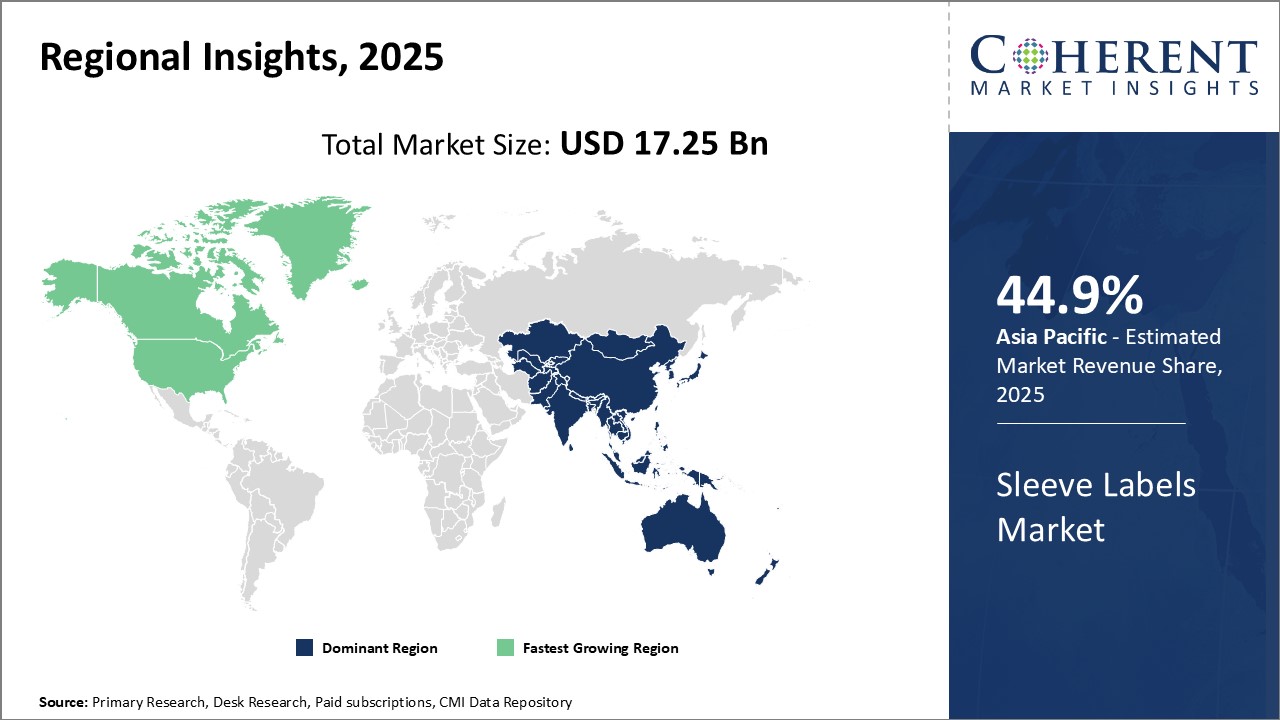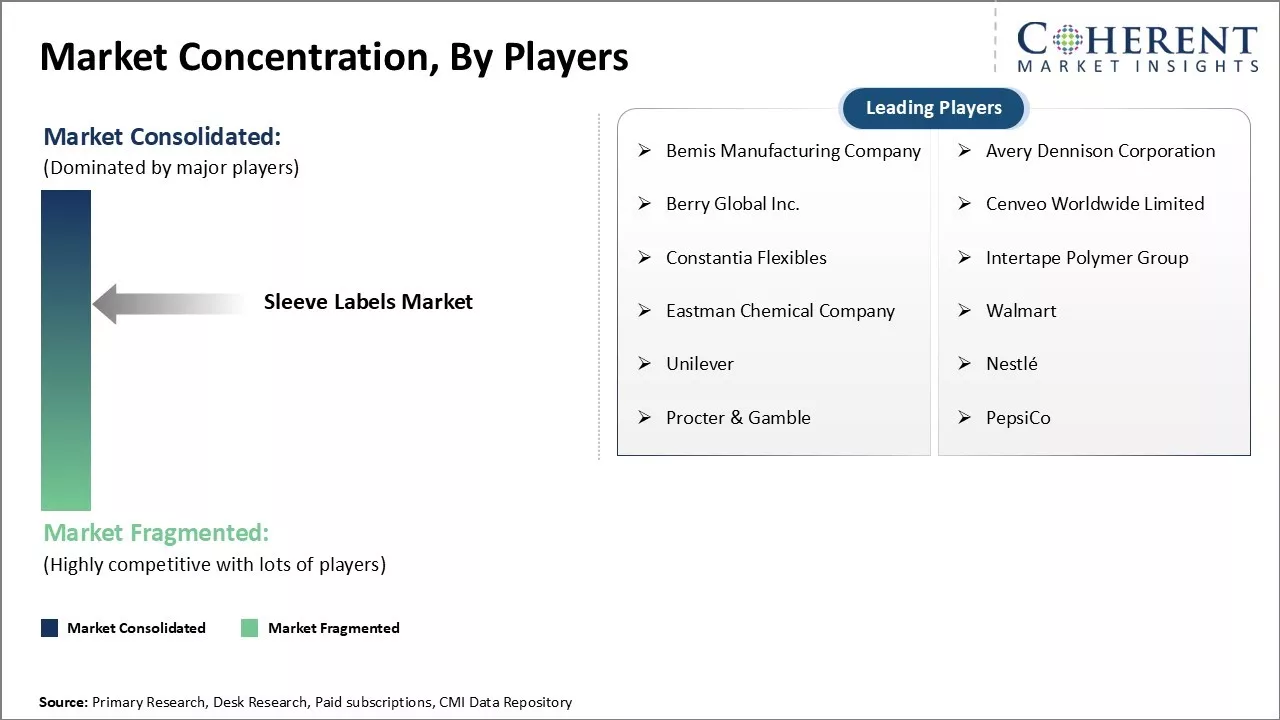The sleeve labels market is estimated to be valued at USD 17.25 Bn in 2025 and is expected to reach USD 25.11 Bn by 2032, exhibiting a compound annual growth rate (CAGR) of 5.5% from 2025 to 2032. The growing demand for packaged goods across industries, such as food and beverages, personal care, and homecare products, is expected to drive the demand for sleeve labels.

Discover market dynamics shaping the industry: Download Free Sample
Increasing demand for flexible packaging from the e-commerce industry along with improved visual appeal of products using sleeve labels has boosted the market growth. Additionally, growing preference for environment-friendly packaging is prompting brand owners to adopt labels made from recycled fiber which helps promote sustainability.

Discover high revenue pocket segments and roadmap to it: Download Free Sample
Insights By Raw Material - Polythene Terephthalate Glycol Dominates due to High Material Performance and Sustainability Factors
In terms of raw material, polythene terephthalate glycol segment is estimated to contribute the highest market share of 38.7% in 2025, owing to its superior material properties and sustainability. Polythene Terephthalate Glycol or PETG is a thermoplastic polymer resin of the polyester family that possesses high strength, stiffness, and dimensional stability properties over other materials.
Insights By Type - Enhanced Product Visibility and Interactive Communication Drive Stretch Sleeves Segment Growth
In terms of type, stretch sleeves segment is estimated to contribute the highest market share of 52.8% in 2025, owing to their ability to maximize visibility and enable interactive communication. Stretch sleeves closely hug the packaging contours and create a tight, wrinkle-free surface perfect for high resolution printing and graphics. The form fitted appearance amplifies the product branding prominently displaying it on shelves.
Insights, By End-use Industry - Greater Customer Appeal and Compliance Drive Food Segment
In terms of end-use industry, food segment is estimated to contribute the highest market share of 26.9% in 2025, owing to tighter statutory packaging norms and emphasis on customer appeal. Being a consumable product with implications on health and safety, food packaging demands precise ingredient listing, nutritional facts, allergen warnings, and expiration dates mandated by regulations.

Need a Different Region or Segment? Download Free Sample
Regional Analysis:
Dominating Region: Asia Pacific
Asia Pacific is expected to dominate the market in 2025 with an estimated share of 44.9%. Stringent government regulations regarding product information and ingredient labeling have also boosted demand. Further, growing demand for consumer goods along with preference for packaged foods augur well for the market.
Fastest-Growing Region: North America
The North America region exhibits the fastest growth, led by the U.S. and Canada and other emerging economies. Rapid industrialization, rising disposable incomes, and growing middle-class population are fueling market growth. Efforts by regional governments to attract foreign investments have encouraged expansion of end-use industries.
Sleeve Labels Market Outlook for Key Countries
Strong Growth Driven by Demand for Innovative, Sustainable Packaging Solutions in the U.S.
The U.S. sleeve labels market is experiencing robust growth, driven by the increasing demand for innovative packaging solutions across various industries including food and beverages, cosmetics, and pharmaceuticals. Advancements in printing technology and materials are enhancing label quality and sustainability, appealing to environmentally conscious consumers. Manufacturers are focusing on meeting stringent regulatory standards, which boosts the demand for high-quality, compliant sleeve labels.
Canada’s Growing Trend of Customization
The Canada sleeve labels market is witnessing a rise in the use of sleeve labels due to growing consumer preference for customizable and visually appealing packaging. There is a strong emphasis on sustainable packaging solutions, with increasing adoption of recyclable and biodegradable materials in label production. Key sectors such as food and beverage and personal care are driving the demand for sleeve labels, promoting innovation in design and functionality.
Premium Packaging and Advanced Printing Technologies Drive Innovation in Branding and Consumer Engagement in Japan
Japan sleeve labels market is characterized by high-quality standards and a strong emphasis on aesthetics. The demand for premium packaging is prevalent in the food and beverage sector. Japanese manufacturers are leading in advanced printing technologies and smart labeling solutions, enhancing product visibility and consumer engagement. The importance of presentation and branding in Japanese culture drives innovation in sleeve label designs.
Rapid Expansion Driven by Urbanization, Changing Lifestyles, and Growing Demand for Packaged Products in India
The India sleeve labels market is expanding rapidly due to the growing packaging industry and increasing demand for consumer goods. Urbanization and changing lifestyles are contributing to the higher consumption of packaged products, driving demand for effective labeling solutions. Manufacturers are focusing on cost-effective and efficient labeling solutions to cater to a diverse market.
Growth Driven by E-Commerce Boom and Demand for Innovative, Sustainable Packaging Solutions
China sleeve labels market is one of the largest globally, fueled by the booming e-commerce sector and rising demand for packaged goods. There are a significant push toward innovative and sustainable packaging solutions, with an emphasis on eco-friendly materials and designs.

Get actionable strategies to beat competition: Download Free Sample
Top Strategies Followed by Sleeve Labels Market Players
Emerging Startups in the Sleeve Labels Market
Several startups are developing innovative technologies to influence the industry's dynamics. Smart Label Solutions Inc. uses printed electronics to embed sensors, memory chips, and connectivity within labels. These "smart labels" can monitor products, store digital information, and connect to IoT networks, paving way for Industry 4.0 applications.
Some startups focus on sustainability. Brandkilla makes plant-based paper labels using agricultural waste fibers as a replacement for plastic. Their eco-friendly solutions help companies meet sustainability goals and appeal to conscious consumers. Nuconic develops waterless label adhesives from renewable plant resins to reduce water consumption during production and disposal. Startups also address unique market needs and form collaborations. A Canada-based firm, Liberty Tabletop, designs custom paper sleeves and labels for the craft beer industry.
Key Takeaways from Analyst
Sleeve Labels Market Report Coverage
| Report Coverage | Details | ||
|---|---|---|---|
| Base Year: | 2024 | Market Size in 2025: | USD 17.25 Bn |
| Historical Data for: | 2020 To 2024 | Forecast Period: | 2025 To 2032 |
| Forecast Period 2025 to 2032 CAGR: | 5.5% | 2032 Value Projection: | USD 25.11 Bn |
| Geographies covered: |
|
||
| Segments covered: |
|
||
| Companies covered: |
Bemis Manufacturing Company, Avery Dennison Corporation, Berry Global Inc., Cenveo Worldwide Limited, Constantia Flexibles, Intertape Polymer Group, Eastman Chemical Company, Walmart, Unilever, Nestlé, Procter & Gamble, and PepsiCo |
||
| Growth Drivers: |
|
||
| Restraints & Challenges: |
|
||
Uncover macros and micros vetted on 75+ parameters: Get instant access to report
Market Driver - Growth in end-use industries
The market has been witnessing significant growth over the past few years primarily attributed to the expansion of major end-use industries where sleeve labels find widespread applications. With hectic lifestyles and preference for convenience foods, the packaged food market has been experiencing steady rise in both developing and developed nations. For instance, according to data by UN Food and Agriculture Organization reported in 2020, the share of packaged food in total food sales increased from 35% in 2000 to 40% in 2020 worldwide.
Market Challenge - Raw material price volatility
One of the major challenges faced by the market is the volatility in raw material prices. Sleeve labels are primarily made from papers, films, and adhesives whose prices tend to fluctuate frequently depending on global demand-supply dynamics and macroeconomic conditions. The Food and Agriculture Organization (FAO) reportedin October 2024, that its food price index averaged 140.9 points in March 2022, up by 33.6% from the corresponding period in 2021.
Market Opportunity - Digital Printing Technology
Digital printing technology presents a huge opportunity for growth in the market. Digital presses allow on-demand, short-run printing in smaller batches with higher design flexibility compared to traditional lithography. Digital printing technology allows the on-demand production of sleeve labels with no quantity limitations and significantly reduced set-up times. This offers new avenues for sleeve label manufacturers to cater to the growing demand for variety and personalization from brand owners.
Share
Share
About Author
Kalpesh Gharte is a senior consultant with approximately 5 years of experience in the consulting industry. Kalpesh holds an MBA in Operations and Marketing Management, providing him with a strong foundation in market strategy and analysis. He has contributed to various consulting and syndicated reports, delivering valuable insights that support informed business decisions
Missing comfort of reading report in your local language? Find your preferred language :
Transform your Strategy with Exclusive Trending Reports :
Frequently Asked Questions
Joining thousands of companies around the world committed to making the Excellent Business Solutions.
View All Our Clients